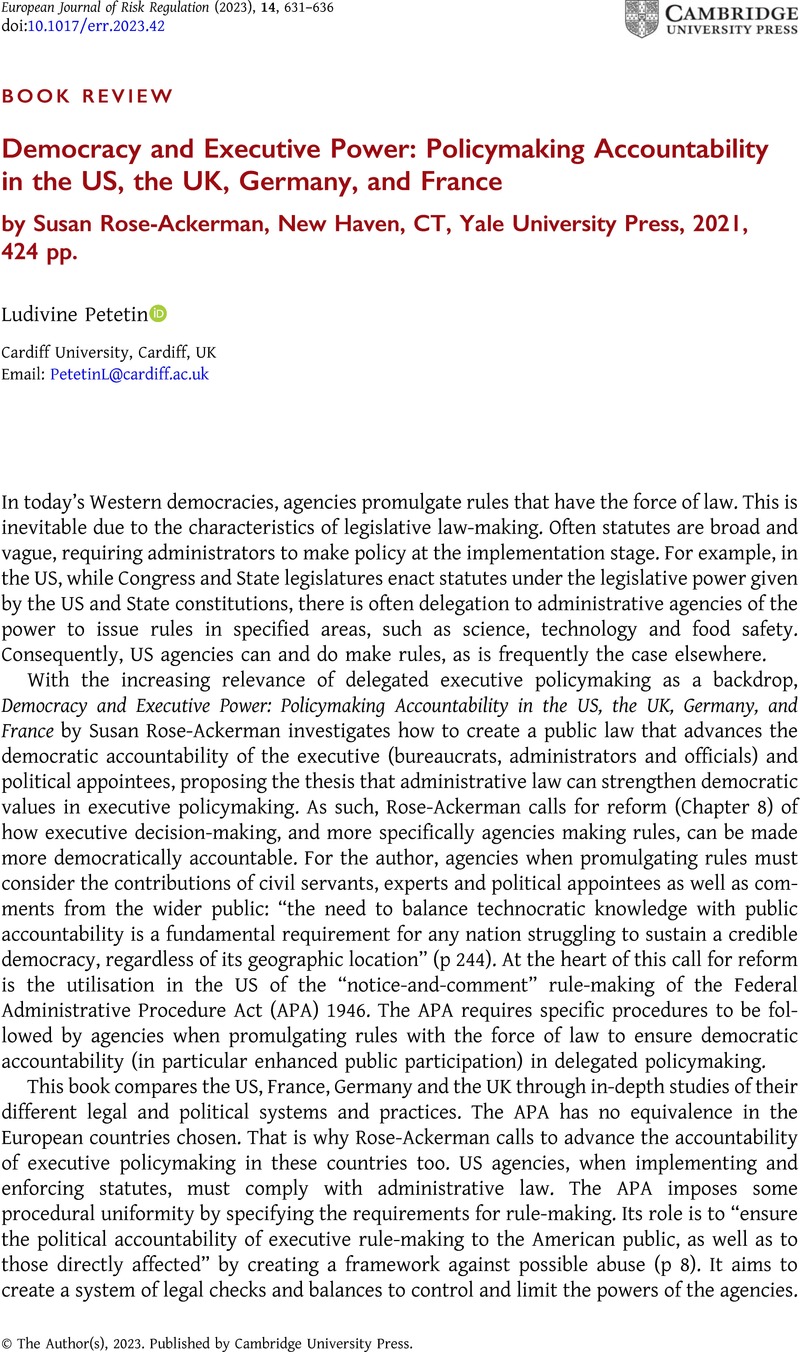Published online by Cambridge University Press: 09 June 2023

1 J Lubbers, A Guide to Federal Agency Rulemaking (4th edition, Chicago, IL, American Bar Association 2006) p 6.
2 M Shapiro, “The Giving Reasons Requirement” (1992) 8(1) University of Chicago Legal Forum 179, 180.
3 ibid, 181.
4 J Webb Yackee and S Webb Yackee, “A Bias towards Business? Assessing Interest Group Influence on the U.S. Bureaucracy” (2006) 68(1) The Journal of Politics 128.
5 GJ Stigler, “The Theory of Economic Regulation” (1971) 2(1) The Bell Journal of Economics and Management Science 3; RA Posner, “Theories of Economic Regulation” (1974) 5(2) The Bell Journal of Economics and Management Science 335.
6 Convention on Access to Information, Public Participation in Decision-Making and Access to Justice in Environmental Matters Aarhus (1998).
7 M Maggetti and K Verhoest, “Unexplored Aspects of Bureaucratic Autonomy: A State of the Field and Ways Forward” (2014) 80(2) International Review of Administrative Sciences 239.
8 See in the EU the comitology procedure. See European Commission, “Comitology”, available at <https://commission.europa.eu/law/law-making-process/adopting-eu-law/implementing-and-delegated-acts/comitology_en>.
9 European Commission, “Impact assessments”, available at <https://commission.europa.eu/law/law-making-process/planning-and-proposing-law/impact-assessments_en>.
10 For more on the precautionary principle in the EU and its relationship with genetically modified foods, see L Petetin, “The Precautionary Principle and Non-Scientific Factors in Biotech Foods” (2017) 8(1) European Journal of Risk Regulation 106.
11 BS Noveck, “The Electronic Revolution in Rulemaking” (2004) 53(2) Emory Law Journal 433.
12 The definition of public participation chosen is the following (p 146): “forums of exchange that are organised for the purpose of facilitating communication between government, citizens, stakeholders and interest groups, and businesses regarding a specific decision or problem”. This definition can be found in O Renn, T Webler and P Wiedemann, “A Need for Discourse on Citizen Participation: Objectives and Structure of the Book” in O Renn, T Webler and P Wiedemann (eds), Fairness and Competence in Citizen Participation: Evaluating Models for Environmental Discourse (Berlin, Springer 1995).
13 For more on the consequences of Brexit, especially for agriculture, see L Petetin and M Dobbs, Brexit and Agriculture (Legal Perspectives on Brexit; Abingdon, Routledge 2022).
14 LE Blais and WE Wagner, “Emerging Science, Adaptive Regulation, and the Problem of Rulemaking Ruts” (2008) 86 Texas Law Review 1701, 1704; TO McGarity, “Some Thoughts on ‘Deossifying’ the Rulemaking Process” (1992) 41(6) Duke Law Journal 1385.
15 Blais and Wagner, supra, note 14, 1705.
16 Similarly, the EU is increasingly relying on soft law. For more, see O Stefan, “The Future of European Union Soft Law: A Research and Policy Agenda for the Aftermath of Covid-19” (2020) 7(2) Journal of International and Comparative Law 329.
17 L Petetin, “The Regulation of Modern Agricultural Biotechnology in EU, US and WTO Law: What Role for Substantial Equivalence and Consumer Preferences?” (PhD thesis, University of Leeds), available at <https://ethos.bl.uk/OrderDetails.do?uin=uk.bl.ethos.581948>.
18 E Seiguer and JJ Smith, “Perception and Process at the Food and Drug Administration: Obligations and Trade-Offs in Rules and Guidance” (2005) 60 Food and Drug Law Journal 1723.
19 The National Bioengineered Food Disclosure Law 2016 required the US Department of Agriculture to establish a national mandatory standard for labelling foods that are or may be bioengineered. Labelling GM foods is now compulsory in the US.
20 E Gellhorn and RM Levin, Administrative Law and Process in a Nutshell (5th edition, St. Paul, MN, Thomson West 2006) p 351.